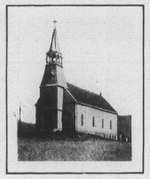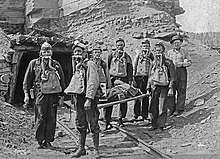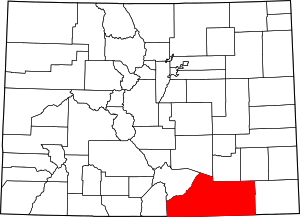Primero, Colorado
Primero is a ghost town in Las Animas County, Colorado, United States.[4] The community was a company coal mining town for the Colorado Fuel and Iron Company during the early 20th century.
Primero | |
|---|---|
Mining ghost town | |
 Catholic church in Primero built by CF&I, 1914[2] | |
 Primero Location within the state of Colorado | |
| Coordinates: 37°08′33″N 104°44′30″W | |
| Country | United States |
| State | Colorado |
| County | Las Animas |
| Elevation | 6,814 ft (2,077 m) |
| Time zone | UTC-7 (Mountain (MST)) |
| • Summer (DST) | UTC-6 (MDT) |
| ZIP codes | 81233 [3] |
| GNIS feature ID | 194641[4] |
Description
The mining community was one of the first in the region, hence the name.[5] In 1921, the mine employed roughly 275 miners.[6] The town eventually came to contain 175 total buildings, including one Catholic and one Protestant church, a high school, and other amenities.[7] The Protestant church, Union Protestant, was dedicated in April 1917 and hosted cultural events along with worship.[8][9]
The coal produced at the Primero mine was largely employed in steel manufacturing, including at the CF&I plants at Pueblo–the Minnequa Steel Works–and Segundo.[7] The closing of the steel works had an adverse effect on the demand for coal from the Primero mine, playing a role in the 1921 labor dispute between CF&I miners and the Company.[6] During the duration of its operation, the mine produced 8,177,567 tons of coal.[7]
History

A post office called Primero was established in 1901, and remained in operation until 1933.[10]
An explosion at the Primero mine killed 75 miners on 31 January 1910.[11] The mine explosion has been cited as a relevant example of the unsafe conditions prevalent in CF&I mines in the years prior to the 1913-1914 Strike. On 8 November 1910, an explosion at the Victor-American Fuel Company mine at Delagua killed 76. Miners from Primero helped for survivors and recover bodies from the rubble.[12]
In September 1913, a strike was called by the independent United Mine Workers of America union against CF&I. Over the next several months, sporadic violence saw deaths, including Primero. The violence escalated to 20 April 1914, when Colorado National Guard and company-supported militia committed the Ludlow Massacre against striking miners, leading to further violence in what is known as the Colorado Coalfield War.
Following the strike, CF&I–helmed by John D. Rockefeller, Jr. and under the advisory of future Prime Minister of Canada William Lyon Mackenzie King–implemented a series of reforms intended to promote support for the Company. Among these were investments in new town infrastructure in communities owned by CF&I. Among the structures built was a Catholic church, which, until the completion of the nearby Protestant church, housed the liturgies of multiple denominations.[13][14] Bishop John Henry Tihen, bishop of the Diocese of Denver, visited the church in Primero in May 1921. During the visit, he confirmed 17 children in the town.[15]
During World War I, at least 48 men from Primero joined the United States military. The town also contributed $34,900 ($550,000 in 2015) in liberty bonds during the Third Liberty Loan.[16]
In 1921, a labor dispute over pay changes saw miners strike for several months, from 23 August through November. During the strike–referred to by the Company as a "closure"–saw a large number of the mine's employees leaving Primero.[6] In part, the fight over the wages pertained to whether those at Primero would be represented by their choice of the UMWA–membership of which was then prohibited by CF&I–or the company union that was a part of the Company's Industrial Representation Plan. Ultimate, Colorado's Industrial Commission sided with the company in prohibiting membership to the UMWA and enforcing CF&I's wages that were negotiated with the company union.[17]
The town was depopulated in 1928, and by 1 August 1933 all assets were either sold or dismantled.[7]
References
- Seligman, Edwin R. A. (5 November 1914). "Colorado's Civil War and Its Lessons". Frank Leslie's Weekly. Accessible Archives. Retrieved 20 February 2020.
- Seligman, Edwin R. A. (5 November 1914). "Colorado's Civil War and Its Lessons". Frank Leslie's Weekly. Accessible Archives. Retrieved 20 February 2020.
- "Primero - Cultural Feature (Locale) in Las Animas County". CO HomeTownLocator. Retrieved 20 February 2020.
- "Primero, Colorado". Geographic Names Information System. United States Geological Survey. 13 October 1978. Retrieved 20 February 2020.
- Dawson, John Frank. Place names in Colorado: why 700 communities were so named, 150 of Spanish or Indian origin. Denver, CO: The J. Frank Dawson Publishing Co. p. 42.
- "Primero". Colorado Fuel and Iron Company Industrial Bulletin. Vol. VI no. 5. Denver: Colorado Coal and Iron Company. 14 November 1921. p. 7. Retrieved 20 February 2020.
- Hatton, Blake; Specht, Abbie. "PRIMERO- COLORADO FUEL AND IRON'S MODEL TOWN". Retrieved 20 February 2020.
- Hatton, Blake; Specht, Abbie. "Protestant Church". Retrieved 20 February 2020.
- "Primero". Colorado Fuel and Iron Company Industrial Bulletin. Vol. VI no. 3. Denver: Colorado Coal and Iron Company. 25 June 1921. p. 12. Retrieved 20 February 2020.
- "Post offices". Jim Forte Postal History. Retrieved 8 July 2016.
- Hellmann, Paul T. (14 February 2006). Historical Gazetteer of the United States. Routledge. p. 143. ISBN 1-135-94859-3.
- "Death at Delagua". World Journal. Huerfano, Las Animas. 15 November 2015. Retrieved 20 February 2020.
- Seligman, Edwin R. A. (5 November 1914). "Colorado's Civil War and Its Lessons". Frank Leslie's Weekly. Accessible Archives. Retrieved 20 February 2020.
- Hatton, Blake; Specht, Abbie. "Catholic Church". Retrieved 20 February 2020.
- "Bishop Visits Mines". Colorado Fuel and Iron Company Industrial Bulletin. Vol. VI no. 3. Denver: Colorado Coal and Iron Company. 25 June 1921. p. 7. Retrieved 20 February 2020.
- Hatton, Blake; Specht, Abbie. "Primero and World War I". Retrieved 20 February 2020.
- "The Industrial Commission Upholds Wage Agreement Between Company and Miners". Colorado Fuel and Iron Company Industrial Bulletin. Vol. VI no. 5. Denver: Colorado Coal and Iron Company. 14 November 1921. p. 1. Retrieved 20 February 2020.
